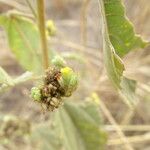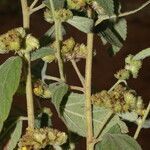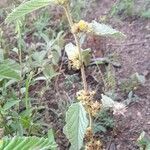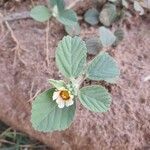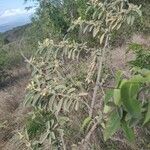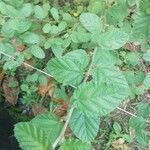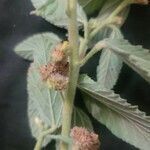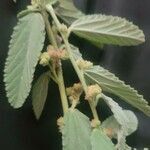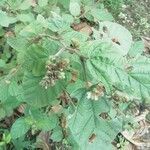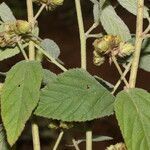Herb or small shrub 0.60-2 m. high, the young stems grayish and soft-velvety-lanate-arachnoid. Leaves with a pedicel 0.5-3.3 cm. long, lanate-arachnoid to sericeous, the stipules subfiliform, the blade narrowly ovate to ovate, rounded or truncate or somewhat subcordate at the base, obtuse or subacute at the apex, 3.5-12 cm. long and 1.5-7 cm. wide, chartaceous, the margins serrate-crenate, grayish and soft-velvety-lanate-arachnoid on both sides, the indumentum slightly denser on the lowger surface, the nervation not reticulate, impressed above and prominent below. Inflorescences axillary or terminal, of tight-globose, subsessile to long-pedunculate glomerules, the peduncles lanate-arachnoid to sericeous. Flowers sessile, the bracts linear-lanceolate, about as long as the flowers, sericeous; calyx tubular-campanulate, somewhat 5-angled, ca. 4-4.5 mm. long, divided about 112 way into 5 triangular-subulate lobes ca. 2-2.5 mm. long, long-sericeous outside, glabrous inside except the sericeous lobes; petals obovate-oblong, unguiculate, 4-4.5 mm. long and 1-1.5 mm. wide, yellow or orange, glabrous outside, scatteringly arachnoid near the base just above the claw inside; staminal tube ca. 2 mm. long, glabrous; anthers subsessile, ca. 0.8 mm. long; ovary oblong-ellipsoid, ca. 1.5 mm. long and 0.75 mm. wide, sericeous on the upper half; style geniculate in the middle, ca. 1.5 mm. long, loosely arachnoid; stigma plumose-papillate. Capsule included in the calyx and surrounded by the marcescent corolla, obovoid, ca. 2.5-3 mm. long and 1.5-2 mm. wide, sericeous above, 1-seeded; seed obovoid, ca. 1.8-2.1 mm. long and 1-1.3 mm. wide, the testa smocth.
Plants branched or nearly simple, to 7–12 dm, indument variable, tomentose to short-woolly, sparsely to densely pubescent. Stems to 8 mm wide, nodes even or extended to 0.5 mm. Leaves: stipules linear-triangular, 3–6 mm; petiole 2.5–5 cm × 1–4 mm; blade concolor or discolor, drying olive, ovate-oblong to lanceolate, to 7(–10) × 5 cm, base subcordate to obtuse, margins crenate-serrate, serrate, irregularly serrate, or crenate-dentate, apex narrowly rounded, obtuse, or subacute, surfaces tomentose or pubescent, trichome rays 0.4–1 mm, and sparsely hispidulous, slightly scabrous or not. Inflorescences subsessile, or on short pedunclelike lateral branches to 3.6 cm, glomerules 5–20 along stems, compact, often dense, sympodial, at times lax clusters with terminal flower and subtending dichasia; bracteoles free or with 1 adherent to stipule forming an elliptic 2-cuspidate foliole at glomerule base, bracts subequal, lanceolate or linear, 0.3–1.5 mm wide, apex acute, entire. Flowers sessile or subsessile; calyx 4.2–setose apically; styles 0.9–1.7 × 0.1–0.3 mm, lateral or excentric, broader and stellate-hirsute distal to base; stigmas 12-branched, plumose (1.2–1.4 × 0.5–0.8 mm, column 0.9–1.2 mm, branches to 0.7 mm) or dissolute-penicillate (0.6–1.2 × 0.7–1.6 mm, column 0.4–0.7 mm, branches to 1.1 mm). Capsules oblique, obconic, or obovoid, 2.1–3 × 1.5–2 mm, walls with endocarp corneous for 1+ mm from apex, sometimes merely membranous along one or both valve margins laterally; partially apically dehiscent to 2-valvate. Seeds dark brown, obovoid or obconic, 2–2.2 × 1.2–1.5 × 1–1.3 mm, smooth. 2n = 24, 26 (India), 40 (Africa).
Erect or ascending subshrubs, up to 1 m tall, multi-branched. Branchlets densely puberulent. Petiole 0.5-1 cm; leaf blade ovate or long elliptic-ovate, 2.5-4.5 × 1.5-3 cm, both surfaces densely puberulent, base rounded or shallowly cordate, margin serrulate, apex obtuse. Inflorescence cymose, capitate, axillary; peduncle nearly absent to 1.5 cm. Epicalyx lobes nar-rowly lanceolate, ca. 4 mm. Calyx tube-shaped, 5-lobed, 3-4 mm, lobes triangular, much longer than tube. Petals yellowish, spatulate, apex truncate, slightly longer than sepals. Filament tube enclosing ovary. Ovary sessile, puberulent; style inserted obliquely; stigma fimbriate. Capsule obovoid, ca. 3 mm, hairy, 1-seeded, enclosed by persistent calyx. Seed obovate, very small. Fl. summer-autumn.
A herb or shrub. It grows 4 m high. The leaves are simple and 2-10 cm long by 1-4 cm wide. There are white stellate hairs on both sides. The flowers are in groups in the axils of leaves or at the ends of branches. The flowers are 3-4 mm wide. They have 5 yellow or orange petals. The fruit is a capsule. They are brown and 2 mm long and have 1 valve. They are tightly clustered together and are hairy. There is 1 seed.
Flowers yellow, in dense subsessile or long-pedunculate, axillary, globose heads, or the upper inflorescences forming a short interrupted or continuous spike, or irregularly collected into dense, leafy or leafless cymes or corymbs; bracts and bracteoles about as long as the flowers, linear or linear-lanceolate, tomentose outside.
Leaf-lamina up to 9 × 4 cm., ovate-oblong to oblong, apex obtuse or subacute, margin serrate-crenate, base rounded and 5-nerved, nervation somewhat impressed above, prominent below; petiole up to 3·3 cm. long.
Stamens with the filaments united into a tube shorter than the petals; anther-thecae parallel, bluntly mucronate at base and apex.
Petals as long as or slightly longer than the calyx, obovate-oblong, shortly clawed, glabrous or the apex stellate-ciliolate.
Shrublet, up to 1 m high. Flowers congested in axillary glomerules. Petals 4.00 x 1.25 mm. Calyces hirsute. Flowers yellow.
Ovary oblong-ovoid, hirsute in the upper half; style pubescent, somewhat excentric, c. 1·5 mm. long; stigma penicillate.
Bushy herb usually 0·6–1·3 m. tall, rather sparsely stellate-pubescent to stellate-tomentose in its vegetative parts.
Calyx 2–3 mm. long, campanulate, villous, divided somewhat less than 1/2 way into 5 triangular lobes.
Capsule c. 3 × 2 mm., obovoid, villous above, 1-or rarely 2-seeded.
Seeds c. 2 × 1·4 mm., dark brown, obovoid; testa smooth.
Petals yellow, turning orange or brown with age
Erect herb or shrub to 7 ft. high
